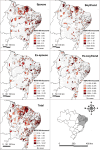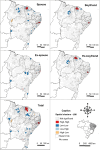Trend and spatial pattern of intimate partner rape notifications against women in Northeast Brazil (2013-2022)
- PMID: 38896650
- PMCID: PMC11182440
- DOI: 10.1590/1980-549720240030
Trend and spatial pattern of intimate partner rape notifications against women in Northeast Brazil (2013-2022)
Abstract
Objective: To analyze the trend and spatial pattern of intimate partner rape reports against women in Northeast Brazil.
Methods: Ecological time-series study and spatial analysis with secondary data from the Notifiable Diseases Information System between 2013 and 2022. Gross rape rates were calculated by type of intimate partner and by age group of the victim. Prais-Winsten regression was used to calculate the trend, and the global and local Moran indices were used for spatial analysis.
Results: A total of 5,542 cases of intimate partner rape were reported. Spousal rates ranged from 0.34/100,000 women in 2013 to 0.51/100,000 in 2017, with greater increases between 2018 (1.04/100 thousand) and 2022 (1.28/100 thousand). There was an upward trend in the Northeast as a whole (APC=19.47; 95%CI 15.88-23.22) and in almost all states, except Paraíba and Sergipe. Cases perpetrated by boyfriends (APC=23.90; 95%CI 12.80-36.09) and among women aged 15 to 19 years (APC=22.63; 95%CI 4.18-44.35) showed the highest annual variation. A concentration of high rates was observed in several municipalities in the northwest of Ceará and southeast of Pernambuco.
Conclusion: The trend in intimate partner rape rates against women increased in the Northeast, especially among younger women and by boyfriends, with a greater agglomeration of notifications in Ceará and Pernambuco.
Conflict of interest statement
Figures


Similar articles
-
Emerging Trends in Intimate Partner Rape and Marital/Spousal Rape During the Biennium 2020 and 2021, Including the COVID-19 Pandemic in Greece.J Interpers Violence. 2025 Jan;40(1-2):370-396. doi: 10.1177/08862605241247552. Epub 2024 May 20. J Interpers Violence. 2025. PMID: 38769870
-
Temporal and spatial analysis of notifications of sexual violence against male children and adolescents in Brazil, 2013 to 2022: an ecological study.Epidemiol Serv Saude. 2024 Oct 14;33:e20231439. doi: 10.1590/S2237-96222024v33e20231439.en. eCollection 2024. Epidemiol Serv Saude. 2024. PMID: 39417521 Free PMC article.
-
Regional disparities in the intimate partner sexual violence rate against women in Paraná State, Brazil, 2009-2014: an ecological study.BMJ Open. 2018 Feb 20;8(2):e018437. doi: 10.1136/bmjopen-2017-018437. BMJ Open. 2018. PMID: 29463587 Free PMC article.
-
Prevalence of intimate partner violence against women in the Arab world: a systematic review.BMC Int Health Hum Rights. 2019 Oct 22;19(1):29. doi: 10.1186/s12914-019-0215-5. BMC Int Health Hum Rights. 2019. PMID: 31640716 Free PMC article.
-
Intimate Partner Violence and Sexual Violence.Emerg Med Clin North Am. 2023 May;41(2):369-380. doi: 10.1016/j.emc.2023.01.007. Epub 2023 Feb 20. Emerg Med Clin North Am. 2023. PMID: 37024170 Review.
References
-
- Sardinha L, Maheu-Giroux M, Stöckl H, Meyer SR, García-Moreno C. Global, regional, and national prevalence estimates of physical or sexual, or both, intimate partner violence against women in 2018. Lancet. 2022;339(10327):803–813. doi: 10.1016/S0140-6736(21)02664-7. - DOI - PMC - PubMed
- 1 Sardinha L, Maheu-Giroux M, Stöckl H, Meyer SR, García-Moreno C. Global, regional, and national prevalence estimates of physical or sexual, or both, intimate partner violence against women in 2018. Lancet 2022; 339(10327): 803-13. 10.1016/S0140-6736(21)02664-7 - DOI - PMC - PubMed
-
- World Health Organization Violence against women [Internet] 2023. [cited on Jul 24, 2023]. Available at: https://www.who.int/health-topics/violence-against-women#tab=tab_1 .
- 2 World Health Organization. Violence against women [Internet]. 2023 [cited on Jul 24, 2023]. Available at: https://www.who.int/health-topics/violence-against-women#tab=tab_1
-
- World Health Organization WHO multi-country study on women's health and domestic violence against women: initial results on prevalence, health outcomes and women's responses [Internet] 2005. [cited on Jul 24, 2023]. Available at: https://www.who.int/publications/i/item/9241593512 .
- 3 World Health Organization. WHO multi-country study on women's health and domestic violence against women: initial results on prevalence, health outcomes and women's responses [Internet]. 2005 [cited on Jul 24, 2023]. Available at: https://www.who.int/publications/i/item/9241593512
-
- Moroskoski M, Brito FAM, Queiroz RO, Higarashi IH, Oliveira RR. Aumento da violência física contra a mulher perpetrada pelo parceiro íntimo: uma análise de tendência. Cien Saude Colet. 2021;26(Supl. 3):4993–5002. doi: 10.1590/1413-812320212611.3.02602020. - DOI - PubMed
- 4 Moroskoski M, Brito FAM, Queiroz RO, Higarashi IH, Oliveira RR. Aumento da violência física contra a mulher perpetrada pelo parceiro íntimo: uma análise de tendência. Cien Saude Colet 2021; 26(Supl. 3): 4993-5002. 10.1590/1413-812320212611.3.02602020 - DOI - PubMed
-
- d’Oliveira AFPL, Schraiber LB, França I, Junior, Ludermir AB, Portella AP, Diniz CS, et al. Fatores associados à violência por parceiro íntimo em mulheres brasileiras. Rev Saude Publica. 2009;43(2):299–311. doi: 10.1590/S0034-89102009005000013. - DOI - PubMed
- 5 d’Oliveira AFPL, Schraiber LB, França-Junior I, Ludermir AB, Portella AP, Diniz CS, et al. Fatores associados à violência por parceiro íntimo em mulheres brasileiras. Rev Saude Publica 2009; 43(2): 299-311. 10.1590/S0034-89102009005000013 - DOI - PubMed
MeSH terms
LinkOut - more resources
Full Text Sources
Medical

